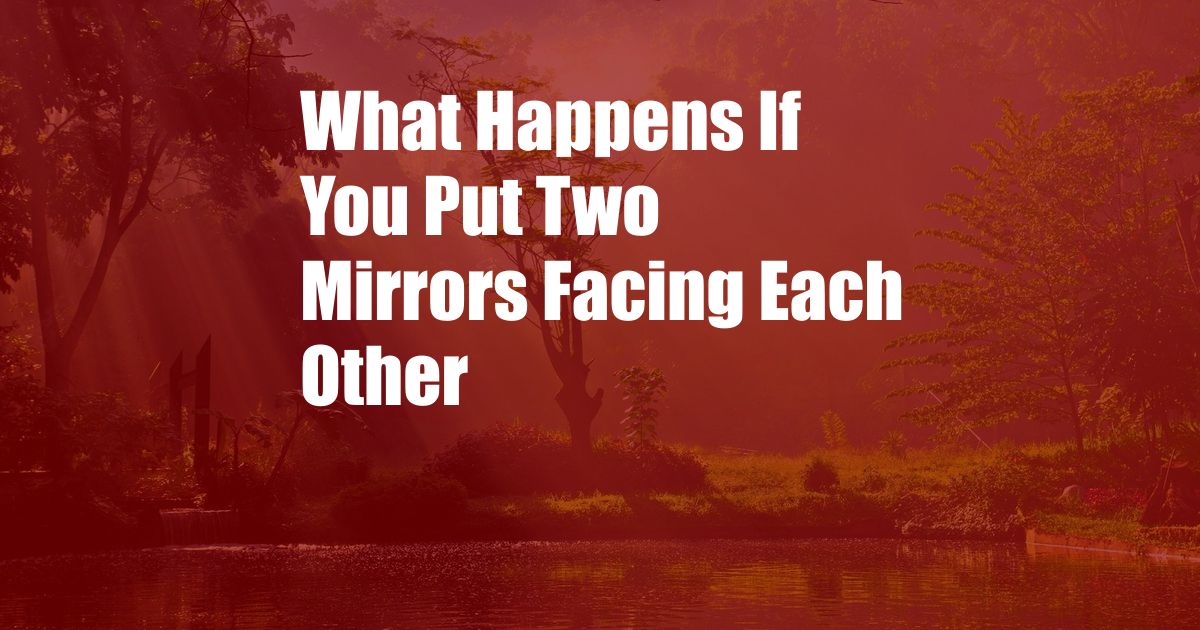
What Happens If You Put Two Mirrors Facing Each Other?
Have you ever wondered what would happen if you placed two mirrors facing each other? As a child, I was fascinated by this concept and couldn’t resist experimenting with it. To my astonishment, I witnessed an endless reflection of myself, creating an intriguing and seemingly infinite void.
This simple yet captivating phenomenon has sparked curiosity and imagination throughout history. From ancient myths to modern-day scientific explorations, the concept of facing mirrors has captivated human minds, revealing insights into the nature of light, infinity, and even our own perception.
The Hall of Mirrors Effect
When two mirrors are placed facing each other, they create a mesmerizing effect known as the “Hall of Mirrors.” As light bounces back and forth between the mirrors, it creates an infinite series of reflections, resulting in a seemingly endless tunnel of images. This phenomenon occurs due to the law of reflection, which states that light rays are reflected off a surface at the same angle they hit it.
In the case of facing mirrors, the light rays bouncing between them create a never-ending cycle of reflections, as each reflection becomes the source for the next. The result is an immersive illusion of depth and endlessness, creating a sense of awe and wonder.
The Physics Behind the Illusion
The Hall of Mirrors effect is a fascinating demonstration of the principles of optics. When light encounters a reflective surface, it undergoes a change in direction based on the angle at which it hits the surface. In the case of facing mirrors, the light rays are reflected back and forth at the same angle, creating a series of parallel lines that appear to recede into infinity.
The intensity of the reflections gradually diminishes as the light travels between the mirrors due to absorption and scattering. This decrease in intensity creates the illusion of depth, making the reflections appear to fade into the distance. The result is an immersive experience that tricks our brains into perceiving an endless void.
Infinity and Beyond
The Hall of Mirrors effect has often been used as a metaphor for infinity, representing the endless possibilities and the boundless nature of the universe. In mathematics, the concept of infinity is often explored through the idea of an infinite series of reflections, which can be used to represent mathematical concepts such as limits and convergence.
In philosophy, the Hall of Mirrors effect has been used to contemplate the nature of reality and self-awareness. The endless reflections can be seen as a representation of the infinite layers of consciousness, leading to questions about our own existence and the boundaries of our perception.
Modern Applications of the Hall of Mirrors
The Hall of Mirrors effect has found practical applications in various fields. In architecture, it has been used to create visually stunning spaces, such as the Hall of Mirrors in the Palace of Versailles. In entertainment, it has been employed in amusement park rides and stage performances to create illusions of depth and movement.
In recent years, the Hall of Mirrors effect has gained renewed attention in the field of quantum computing. Scientists have been exploring the use of quantum mirrors to create quantum entanglement, which is a phenomenon where two particles become interconnected, regardless of the distance between them. This research holds promise for the development of faster and more efficient quantum computers.
Tips and Expert Advice
If you’re interested in experiencing the Hall of Mirrors effect firsthand, here are a few tips:
- Choose large mirrors. Larger mirrors will create a more immersive experience and allow for a greater number of reflections.
- Position the mirrors carefully. To achieve the desired effect, the mirrors should be placed parallel to each other and at a slight angle, allowing the light rays to bounce back and forth.
- Experiment with lighting. Different lighting conditions can create different effects. Dim lighting can enhance the illusion of depth, while brighter lighting can make the reflections more visible.
Common FAQs
- What causes the fading of reflections in the Hall of Mirrors?
The reflections gradually fade as the light travels between the mirrors due to absorption and scattering.
- Is the Hall of Mirrors effect real or an illusion?
The Hall of Mirrors effect is a real phenomenon that can be observed when two mirrors are placed facing each other.
- What is the significance of the Hall of Mirrors effect in quantum computing?
In quantum computing, scientists are exploring the use of quantum mirrors to create quantum entanglement, which holds promise for the development of faster and more efficient quantum computers.
Conclusion
The Hall of Mirrors effect is a captivating phenomenon that has captured the imagination of humans for centuries. From its use in ancient myths to its modern-day applications in architecture and quantum computing, this optical illusion continues to fascinate and inspire us.
Whether you’re interested in exploring the nature of infinity, experimenting with light and reflection, or simply creating a visually stunning space, the Hall of Mirrors effect offers a unique and unforgettable experience. So, next time you have two mirrors, don’t hesitate to give it a try. You may just be surprised at what you discover.
Do you have any questions or experiences related to the Hall of Mirrors effect? Feel free to share them in the comments below!